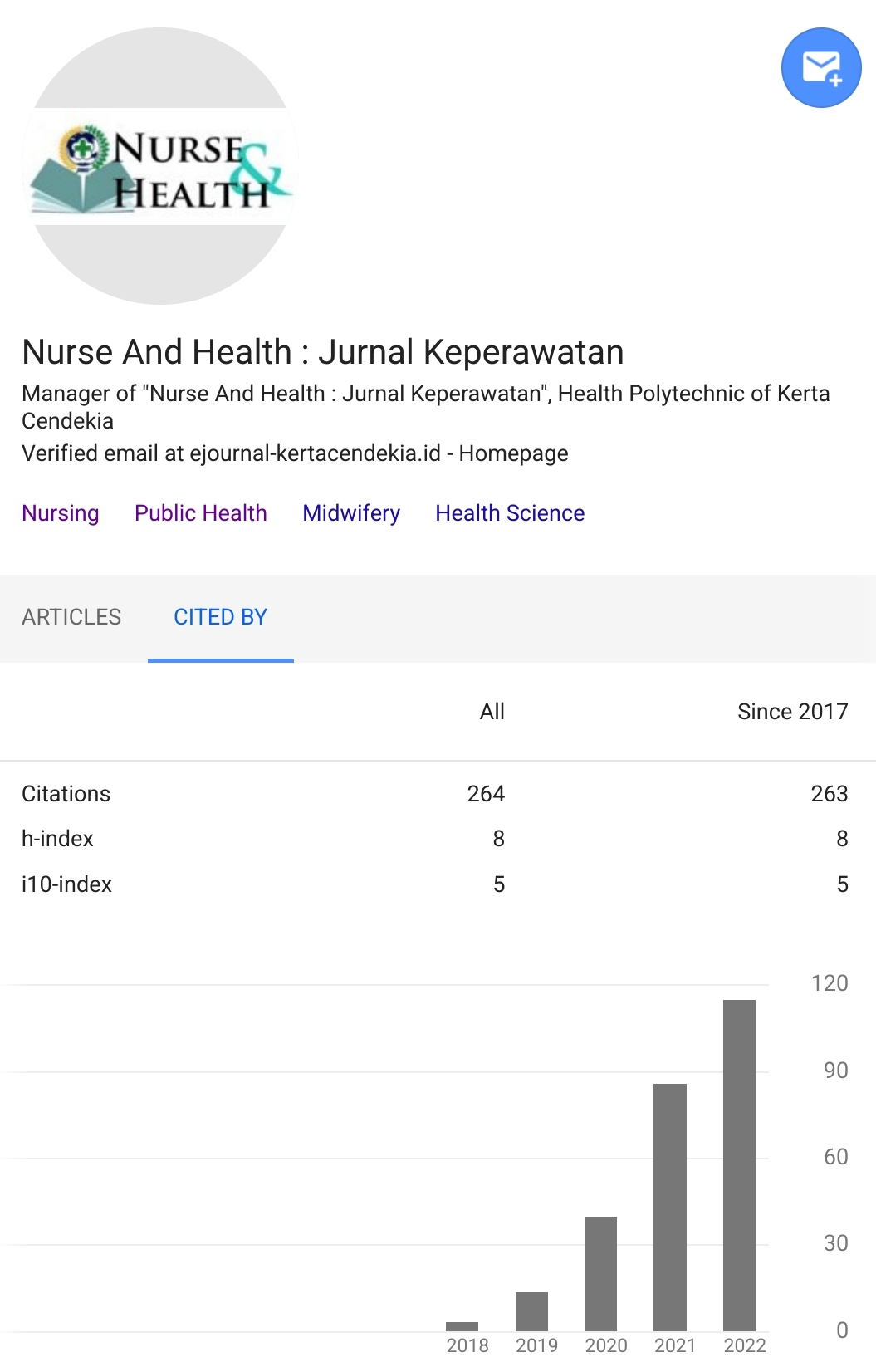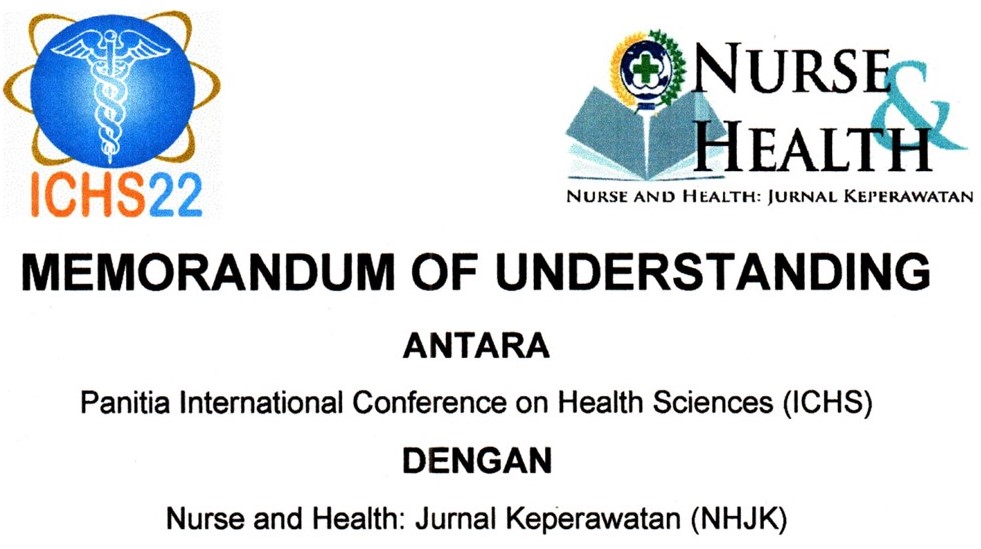ANALYSIS OF FARMERS' INTERNAL FACTORS WITH THE ABILITY TO KNOW HAZARDOUS MATERIALS
Abstract
Background: Work in agricultural areas is one of the occupations that are at risk with the accident and death rates. Hazardous and toxic material is one of the risks that can threaten the health of farmers, which is very important to be known by farmers. Objectives: This study aimed to analyze the internal factors of farmers on the ability to recognize hazardous and toxic materials. Methods: The design of this study used descriptive correlation design. Population in this study are farmers who are members of farmer groups in the working area of the Department of Agriculture in Lumajang Regency who are members of a joint group of farmers under the guidance of the Agriculture Office of Lumajang Regency. The sampling technique in this study used simple random sampling obtained samples were 45 farmers. Instrument of this study demographic data of the respondents and questionnaire that was adopted from PP No. 74, 2001 concerning the management of hazardous and toxic materials in agricultural areas. The questionnaire consists of 25 items with Cronbach Alpha .726. The data of this study were analyzed by one-way ANOVA. Results: Based on the results of the study found that two internal factors of farmers related to the ability of farmers to recognize hazardous and toxic materials in agricultural areas, namely education and work tenure, with a significance level of 0,000 less than 0.05. Education and work tenure of farming affect the experience of farmers so that the level of knowledge of farmers increases. Farmers are more aware of the effects of hazardous and toxic substances on their health according to their level of knowledge. Conclusion: Prevention of poisoning due to hazardous and toxic substances in agricultural areas can be developed by increasing health promotion and increasing farmers' knowledge to become more familiar with hazardous and toxic substances on label recognition, composition, mixing storage and their effects on health. nbsp; Keywords: Hazardous Materials, Toxic Materials, FarmersDownloads
References
Ali, J., Yusof, N., & Fadzli, F. S. (2018). Factors influencing farmer’s perceptions and behavior toward pesticide use in Malaysia. International Journal of Social Economics. https://doi.org/10.1108/IJSE-11-2016-0304
Amilia, E., Joy, B., & Sunardi, S. (2016). Residu Pestisida pada Tanaman Hortikultura (Studi Kasus di Desa Cihanjuang Rahayu Kecamatan Parongpong Kabupaten Bandung Barat). Agrikultura. https://doi.org/10.24198/agrikultura.v27i1.8473
Amsal, Hafid, F., Ramlan, & Masrianih. (2019). Pesticide poisoning in farmers and its risk factors in tolai village, parigi moutong regency, indonesia. Indian Journal of Public Health Research and Development. https://doi.org/10.5958/0976-5506.2019.02056.4
Arista, M., Prasetya, W. E., & Dwi, F. R. (2019). KearifanLokalPetani DalamMengenal DanPenanganan Awal Ancaman Akibat BahanBerbahaya Di Area Pertanian. Jurnal Ilmu Kesehatan, 10, 140–147.
Atreya, K., Sitaula, B. K., & Bajracharya, R. M. (2013). Distribution of health costs of pesticide use by the household economy. Environment, Development, and Sustainability. https://doi.org/10.1007/s10668-012-9414-0
Christie, M. E., Van Houweling, E., & Zseleczky, L. (2015). Mapping gendered pest management knowledge, practices, and pesticide exposure pathways in Ghana and Mali. Agriculture and Human Values. https://doi.org/10.1007/s10460-015-9590-2
Curl, C. L., Spivak, M., Phinney, R., & Montrose, L. (2020). Synthetic Pesticides and Health in Vulnerable Populations: Agricultural Workers. Current Environmental Health Reports. https://doi.org/10.1007/s40572-020-00266-5
de Queiroz, V. T., Azevedo, M. M., da Silva Quadros, I. P., Costa, A. V., do Amaral, A. A., dos Santos, G. M. A. D. A., Juvanhol, R. S., de Almeida Telles, L. A., & dos Santos, A. R. (2018). Environmental risk assessment for sustainable pesticide use in coffee production. Journal of Contaminant Hydrology. https://doi.org/10.1016/j.jconhyd.2018.08.008
Deng, Y., Dai, H., Zeng, M., Guan, L., Luo, X., Zhang, C., Tian, J., Zhang, J., Li, Y., Xu, Q., Zhao, M., Jiang, M., & Zhao, L. (2019). Knowledge and behaviour regarding pesticide use: a survey among caregivers of children aged 1–6 years from rural China. Environmental Science and Pollution Research. https://doi.org/10.1007/s11356-019-05560-w
F.A.Jallow, M., G.Awadh, D., M.Thomas, M., & Y.DeviBinson, S. A. (2017). Pesticide risk behaviours and factors influencing pesticide use among farmers in Kuwait. Science of the Total Environment, 574, 490–498. https://doi.org/https://doi.org/10.1016/j.scitotenv.2016.09.085
Fibriansari, R. D., Maisyaroh, A., & Widianto, E. P. (2019). PENINGKATAN KEMAMPUAN BANTUAN HIDUP DASAR (BHD) AKIBAT BAHAN BERBAHAYA PADA PETANI. BORNEO NURSING JOURNAL (BNJ), 2(1), 1–6.
Hagel, L. M., Pickett, W., Pahwa, P., Day, L., Brison, R. J., Marlenga, B., Crowe, T., Snodgrass, P., Ulmer, K., & Dosman, J. A. (2008). Prevention of agricultural injuries: An evaluation of an education-based intervention. Injury Prevention. https://doi.org/10.1136/ip.2008.018515
Hidayah, N. (2019). CADRE’S EMPOWERMENT AND COUNSELING IN INCREASING SOCIETY’S BEHAVIOR ABOUT CONTENT AND EFFECT OF PESTICIDES ON FRESH VEGETABLES. Proceeding of the 1st International Conference of Kerta Cendekia Nursing Academy 2019 Theme: Improving Quality of Life: Shifting from Hospital-Based to Community-Based Care, 87–94.
ILO. (2015). Indonesia: Decent work for Indonesian migrant workers. International Labour Organization. http://www.ilo.org/wcmsp5/groups/public/---asia/---ro-bangkok/---ilo-jakarta/documents/publication/wcms_366945.pdf
Istianah, F., & Yuniastuti, A. (2017). Hubungan Masa Kerja, Lama Menyemprot, Jenis Pestisida, Penggunaan APD dan Pengelolaan Pestisida dengan Kejadian Keracunan Pada Petani di Brebes. Public Health Perspective Journal, 2(2), 117–123.
Mahmudah, M., Wahyuningsih, N. E., & Setyani, O. (2012). Kejadian Keracunan Pestisida Pada Istri Petani Bawang Merah di Desa Kedunguter Kecamatan Brebes Kabupaten Brebes. Media Kesehatan Masyarakat Indonesia, 11(1), 65–70.
Maisyaroh, A. (2019). Buku Ajar Agronursing.
Maisyaroh, A., Widianto, E. P., & Fibriansari, R. D. (2019). KearifanLokalPetani DalamMengenal DanPenanganan Awal Ancaman Akibat BahanBerbahaya Di Area Pertanian. Jurnal Ilmu Kesehatan, 10(2), 140–147.
Mayasari, D. (2017). Gambaran Perilaku Kerja Aman pada Petani Hortikultura Pengguna Pestisida Di Desa Gisting Atas sebagai Faktor Risiko Intoksikasi Pestisida. JK Unila, 1(3), 530–535.
Mburu, C., Kinyua, R., Karani, G., & Kiiyukia, C. (2018). Occupational Safety and Health Hazards Exposure among Farm Workers at Ahero Irrigation Scheme, Kenya. International Journal of Agriculture and Environmental Research, 4(9), 1–13.
Okoffo, E. D., Mensah, M., & Fosu-Mensah, B. Y. (2016). Pesticides exposure and the use of personal protective equipment by cocoa farmers in Ghana. Environmental Systems Research. https://doi.org/10.1186/s40068-016-0068-z
Pasaribu, S. M., & Sudiyanto, A. (2016). Agricultural risk management: Lesson learned from the application of rice crop insurance in Indonesia. In Climate Change Policies and Challenges in Indonesia (pp. 305–322). Springer Japan. https://doi.org/10.1007/978-4-431-55994-8_14
Sahuleka, N., Rasni, H., & Rifai, A. (2017). Pengaruh Model Pembelajaran Active Learning terhadap Pengetahuan dan Sikap Penggunaan Alat Pelindung Diri (APD) dalam Pencegahan Terjadinya Green Tobacco Sickness (GTS) pada Buruh Tani Tembakau di Desa Plalangan Kecamatan Kalisat Kabupaten Jember. E-Jurnal Pustaka Kesehatan, 5(3), 489–496.
Samosir, K., Setiani, O., & Nurjazuli, N. (2017). Hubungan Pajanan Pestisida dengan Gangguan Keseimbangan Tubuh Petani Hortikultura di Kecamatan Ngablak Kabupaten Magelang. JURNAL KESEHATAN LINGKUNGAN INDONESIA. https://doi.org/10.14710/jkli.16.2.63-69
Sari, chandra W. K. (2018). Kejadian dan Karakteritik cedera pada petani di kecamatan kalisat kabupaten jember.
Satya Sai, M. V., Revati, G. D., Ramya, R., Swaroop, A., Maheswari, E., & Kumar, M. (2019). Knowledge and perception of farmers regarding pesticide usage in a rural farming village, Southern India. Indian Journal of Occupational and Environmental Medicine. https://doi.org/10.4103/ijoem.IJOEM_121_18
Saw, L., Shumway, J., & Ruckart, P. (2011). Surveillance Data on Pesticide and Agricultural Chemical Releases and Associated Public Health Consequences in Selected US States, 2003-2007. In Journal of Medical Toxicology. https://doi.org/10.1007/s13181-011-0152-8
Suparti, S., Anies, & Setiani, O. (2016). BEBERAPA FAKTOR RISIKO YANG BERPENGARUH TERHADAP KEJADIAN KERACUNAN PESTISIDA PADA PETANI. JURNAL PENA MEDIKA, 6(2), 125–138.
Tomer, V., Sangha, J. K., & Ramya, H. G. (2015). Pesticide: An Appraisal on Human Health Implications. Proceedings of the National Academy of Sciences India Section B - Biological Sciences. https://doi.org/10.1007/s40011-014-0388-6
Utami, C. U. (2016). HUBUNGAN PENGETAHUAN, SIKAP, DAN TINDAKAN PENGGUNAAN PESTISIDA DENGAN TINGKAT KERACUNAN PESTISIDA PADA PETANI DI DESA KEMBANG KUNING KECAMATAN CEPOGO.
Widayati, N. (2014). Kualitas Hidup Petani Lanjut Usia Dalam Perspektif Agricultural Nursing.
Widianto, E. P., Maisyaroh, A., & Fibriansari, R. D. (2018). ARISAN sebagai Media Pengurangan Resiko Bahan Berbahaya Pestisida Berbasis Komunitas Kelompok Petani (POKTAN). 1 St ANNUAL AGRICULTURAL HEALTH NURSING SEMINAR: “UPDATE MANAGEMENT AND PREVENTION RELATED TO AGRICULTURAL ACTIVITIES CLINICAL SETTING,” 1–7.
Widianto, E. P., Maisyaroh, A., & Fibriansari, R. D. (2019). Proactive Public Health Approach to Prevention of Occupational Disease on Farmers in Lumajang. Proceeding of the 1st International Conference of Kerta Cendekia Nursing Academy 2019 Theme: Improving Quality of Life: Shifting from Hospital-Based to Community-Based Care, 95–101.
Widianto, E. P., Maisyaroh, A., Fibriansari, R. D., & Astuti, A. (n.d.). Modul Bantuan Hidup Dasar Akibat Bahan Berbahaya dan Alat Mesin Pertanian pada Petani. Bondowoso: KHD Production.
Wumbei, A., Houbraken, M., & Spanoghe, P. (2019). Pesticides use and exposure among yam farmers in the Nanumba traditional area of Ghana. Environmental Monitoring and Assessment. https://doi.org/10.1007/s10661-019-7449-5
Zhang, X., Wu, M., Yao, H., Yang, Y., Cui, M., Tu, Z., Stallones, L., & Xiang, H. (2016). Pesticide poisoning and neurobehavioral function among farmworkers in Jiangsu, People’s Republic of China. Cortex. https://doi.org/10.1016/j.cortex.2015.09.006
Authors who publish with Nurse and Health: Jurnal Keperawatan agree to the following terms:
- Authors retain copyright licensed under a Creative Commons Attribution-NonCommercial 4.0 (CC BY-NC 4.0), which allows others to remix, tweak, and build upon the authors' work non-commercially, and although the others' new works must also acknowledge the authors and be non-commercial, they don't have to license their derivative works on the same terms.
- Authors are permitted and encouraged to post their work online (e.g., in institutional repositories or on their website) prior to and during the submission process, as it can lead to productive exchanges, as well as earlier and greater citation of published work (See The Effect of Open Access). Authors can archive pre-print and post-print or publisher's version/PDF.








_resize1.jpg)















